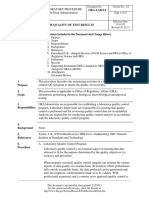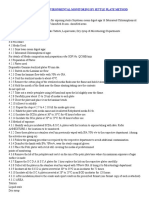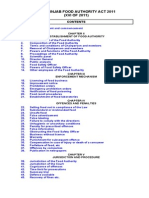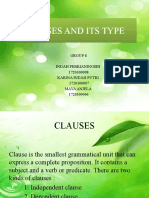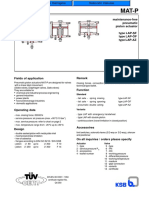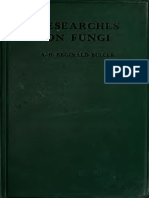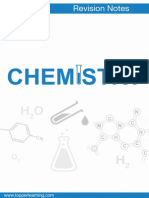Procedure For Sampling
Procedure For Sampling
Uploaded by
WaqarAhmedButtCopyright:
Available Formats
Procedure For Sampling
Procedure For Sampling
Uploaded by
WaqarAhmedButtOriginal Description:
Original Title
Copyright
Available Formats
Share this document
Did you find this document useful?
Is this content inappropriate?
Copyright:
Available Formats
Procedure For Sampling
Procedure For Sampling
Uploaded by
WaqarAhmedButtCopyright:
Available Formats
Procedure for Sampling
1.0 PURPOSE
The purpose of this procedure is to guide laboratory staff about the safe handling of the
sample handling.
2.0 SCOPE
This procedure is applicable on the activities related to the following;
a. Sampling
b. Receiving
c. Identification
d. Handling
e. Storage
f. Disposal
3.0 RESPONSIBILITIES
3.1 DMR is responsible to ensure execution of this procedure
3.2 Lab Analyst is to maintained related records as mentioned
4.0 PROCEDURE
4.1 Sampling Plan
Sampling for routine testing at ENTERPRISE is carried out as per the Quality Plan.
The plan consists of the following information;
Area from where the sample is to be taken i.e. 1, 2, 3.
Sample point from where it is taken
Type of sample collected i.e. liquid, gas etc.
Quantity of the sample drawn. Generally the quantity of the sample is taken in such
a way that meets the requirement for the testing of each parameter three times
Sampling frequency i.e. daily, weekly or monthly
Sample units i.e. uS / cm, ppm
4.2 Sampling Frequency
Sampling frequency for routine testing is defined on the said Quality Plan. The
determination of sampling frequency depends on the following factors;
Customer Requirements
Process requirements
Legal / Statuary requirements
However, for special and additional check samples, requests are communicated to
concerned analyst by rep of the relevant department.
4.3 Sample Collection and Handling
4.3.1ENTERPRISE has developed SOPs for collection and handling of different
samples (acidic, basic, liquid, gas, sludge etc.). Lab chemist ensures that SOP
for sampling is followed.
4.3.2Samples are collected either by directly filling appropriate sample container or
by using an automatic sampler or other appropriated device. It is ensured that
collection device does not come into contact with sample containers.
Procedure for Sampling
4.3.3Samples are collected in designated container bottles that are properly labeled.
In order to avoid sample mix up / contamination, lab has developed a
comprehensive color coding scheme. These are;
S#
1
2
3
4
5
6
7
Plant
NP plant
Nitric Acid
Ammonia
Urea
Offsite and Utilities
CAN / AN
Miscellaneous
Color
Blue
Orange
Pink
Yellow
Green
Grey
White
4.3.4The sample collector ensures that following minimum information is mentioned
on the label prior to sample collection;
Sampling Date
Sampling Time
Sample Point
4.3.5Following is considered to ensure better sample collection;
The sample should be collected from predefined location to ensure
compliance
Sampling apparatus must be properly cleaned to avoid cross-contamination
Actual sample container is selected that is to be used to transport the
sample to the laboratory
4.3.6After collection, all samples are submitted in the Sample Collection Bay where
they are inspected prior to further processing.
4.3.7Samples are identified / enlisted in relevant lab notebooks / logbooks by
concerned analysts.
4.3.8The samples that show nonconforming results are isolated and reported to the
Lab Chemist who then proceeds as per the instructions provided in the
Procedure for Control of Nonconforming Testing Work.
4.4 Sample Receiving
4.4.1The lab-sample receiver (Supervisor / Analyst) inspects the incoming samples
(routine / special) and verifies its content by checking the following:
The integrity and condition of all sample containers,
Checks for leakage, cracked or broken closures or containers, evidence of
grossly contaminated container exteriors
Verifies the receipt of complete Sample Tag for each container or set of
containers.
4.4.2After the received samples are verified, special and additional check samples
are logged in Special Samples register prior to proceeding for testing whereas
routine samples are simply transferred to designated work tables.
4.4.3Similarly, the samples found noncompliant to the acceptance criteria are
rejected and entries are made in the Rejected Samples register. In case
rejection exceeds 10% of the total number of samples received in one month
then CPA is raised by Lab Chemist / DMR as per the Procedure for Corrective
and Preventive Actions.
Procedure for Sampling
4.5 Sample Storage
4.5.1Once the sample is received, the laboratory personnel are responsible for the
care and custody of the sample. The samples must be secured in the laboratory
at all times. As they await analysis, the samples are stored in a way that
satisfies requirements for analytic stability, safety and ease of retrieval.
4.5.2In order to avoid sample mix up, lab has designated locations for the storage
and segregation of; samples received for testing, samples under analysis /
testing, samples cleared after testing and samples showing abnormal results.
4.6 Sample Disposal
4.6.1The sample will be disposed when it is certain that the information is no longer
required, or the sample has deteriorated.
4.6.2In case of routine testing other than composite product, samples are simply
disposed-off as per the developed SOPs pertaining to the type of sample like
acid, caustic, product etc..
4.6.3In case of routine testing of composite product, the sample is retained in sealed
bags under appropriate conditions for one month. After completion of its
retention period, the bags are submitted to Product Handling Department where
they are treated as sweep i.e. they are sold in market at discounted price.
4.6.4For samples showing abnormal results, the sample is preserved in lab under
appropriate conditions till further instructions by Lab Chemist. Once declared
clear by the Lab Chemist, they are disposed-off as per the defined SOP for
disposal.
5.0 RELATED DOCUMENTS
5.1 SOP for Sampling of Acid / Caustic / Sodium Hypochlorite Tankers
5.2 SOP for Sampling of Fresh and Used Oil
5.3 SOP for Sampling of Liquid Ammonia from Plant
5.4 SOP for Disposal of Acid, Base And Sodium Hypochlorite Samples after analysis
6.0 RECORDS
6.1 O / U Quality Plan
6.2 Raw Material Quality Plan
You might also like
- Control Sample SOP - SOP For Control Sample ManagementDocument10 pagesControl Sample SOP - SOP For Control Sample ManagementdaribeefaNo ratings yet
- ASEAN TMHS GMP Training Chapter 4 Annex 1 SOP On Personal HygieneDocument5 pagesASEAN TMHS GMP Training Chapter 4 Annex 1 SOP On Personal Hygienesunny mgxNo ratings yet
- SOP For CalibirationDocument3 pagesSOP For CalibirationMuhammad Nisar100% (2)
- Oos Laboratory Investigation Checklist Phase 1aDocument2 pagesOos Laboratory Investigation Checklist Phase 1atghons100% (4)
- Environmental Monitoring Incubation Conditions - JustificationDocument4 pagesEnvironmental Monitoring Incubation Conditions - Justificationveerreddy_157808No ratings yet
- Bronze Star: Powerpoint PresentationDocument34 pagesBronze Star: Powerpoint PresentationwaranchaiNo ratings yet
- ORA-LAB.5.9: Sections Included in This Document and Change HistoryDocument12 pagesORA-LAB.5.9: Sections Included in This Document and Change HistoryPrashansa ShresthaNo ratings yet
- TOTL-SP02 Factilities and Environmental Conditions ProcedureDocument9 pagesTOTL-SP02 Factilities and Environmental Conditions ProcedureahmedNo ratings yet
- Confidentialit SopDocument6 pagesConfidentialit SopVaibhav Gadhawe100% (2)
- Laboratory Cleaning and MaintenanceDocument8 pagesLaboratory Cleaning and MaintenanceJenner ButlongNo ratings yet
- Aka GMP Audit FormDocument8 pagesAka GMP Audit FormAlpian BosixNo ratings yet
- ISO 170252017 RequirementDocument6 pagesISO 170252017 RequirementAkkiNo ratings yet
- Miracle of LifeDocument3 pagesMiracle of Lifespankey0809No ratings yet
- DLP 6 Tle - He Q2 Aug. 26-30 Week 3Document16 pagesDLP 6 Tle - He Q2 Aug. 26-30 Week 3Seo Yeo JinNo ratings yet
- Facilities and Environmental ConditionsDocument3 pagesFacilities and Environmental ConditionsneramopNo ratings yet
- Sops IndexDocument3 pagesSops IndexIbrahim IssaNo ratings yet
- The Concise Calibration & Test Equipment Management Guide: The Concise Collection, #1From EverandThe Concise Calibration & Test Equipment Management Guide: The Concise Collection, #1Rating: 4.5 out of 5 stars4.5/5 (2)
- QSP-001633 - Rev 04 - Luminus Testing Laboratory Quality Manual207Document34 pagesQSP-001633 - Rev 04 - Luminus Testing Laboratory Quality Manual207SureshNo ratings yet
- SOP of GOOD LABORATORIES PRACTICEDocument2 pagesSOP of GOOD LABORATORIES PRACTICEPrince Moni100% (2)
- Purchasing and ReceiptDocument7 pagesPurchasing and ReceiptOsman AitaNo ratings yet
- SOP of Glassware HandlingDocument1 pageSOP of Glassware HandlingPrince Moni100% (2)
- Sop For Analytical Method ValidationDocument3 pagesSop For Analytical Method ValidationDolly Bijani0% (1)
- SOP For Reduce Testing For Raw MaterialDocument3 pagesSOP For Reduce Testing For Raw MaterialMubarak Patel67% (3)
- Quality Manual Template1Document27 pagesQuality Manual Template1Lenana KoikaiNo ratings yet
- SOP ThermometerDocument4 pagesSOP Thermometersuko winarti100% (1)
- Laboratory HouskeepingDocument3 pagesLaboratory HouskeepingTanvir SiddikiNo ratings yet
- Procedure For Environmental Monitoring by Settle Plate MethodDocument2 pagesProcedure For Environmental Monitoring by Settle Plate Methodejazmaqsood100% (1)
- ORA-LAB - QM ORA Laboratory Manual of Quality Policies (v03)Document47 pagesORA-LAB - QM ORA Laboratory Manual of Quality Policies (v03)Ahmad shayebNo ratings yet
- LabSafety PDFDocument18 pagesLabSafety PDFalberto1954100% (1)
- Facilities and Environmental Conditions (Linked To Vol. III, Sec. 2) PDFDocument8 pagesFacilities and Environmental Conditions (Linked To Vol. III, Sec. 2) PDFimran shaukat100% (1)
- SOP of SamplingDocument8 pagesSOP of SamplingaKureishi100% (1)
- SOP Housekeeping&CleaningDocument3 pagesSOP Housekeeping&Cleaningmalik234everNo ratings yet
- Calibration Thermometer PDFDocument7 pagesCalibration Thermometer PDFGilberto Andrés Jurado100% (1)
- SOP For Sampling of Packing MaterialDocument3 pagesSOP For Sampling of Packing MaterialSolomon100% (1)
- Kraft Analytical Laboratory ManualDocument13 pagesKraft Analytical Laboratory ManualrodrigofacearNo ratings yet
- The Sampling of Packaging MaterialDocument3 pagesThe Sampling of Packaging Materialnirbhaya2010No ratings yet
- Purpose:: Validation Type: In-House Validation Critical Limit: AbsenceDocument1 pagePurpose:: Validation Type: In-House Validation Critical Limit: AbsenceMilan BankNo ratings yet
- Lab Equipment CalibrationDocument3 pagesLab Equipment Calibrationjohn100% (1)
- Validation Change Control Maintaining The Validate State-09-2015Document56 pagesValidation Change Control Maintaining The Validate State-09-2015VaLeritha R. Santa MNo ratings yet
- 3) Sop For Cleaning & Sanitation of Microbiolgy LaboratoryDocument4 pages3) Sop For Cleaning & Sanitation of Microbiolgy LaboratoryEnam HaqNo ratings yet
- Laboratory Housekeeping: 1.0 PurposeDocument3 pagesLaboratory Housekeeping: 1.0 PurposeAbu MuazNo ratings yet
- SOP On Handling of Critical and Non-Critical DeviationsDocument6 pagesSOP On Handling of Critical and Non-Critical DeviationsRajnish PatilNo ratings yet
- Calibration and Maintenance of Measuring and Monitoring Devices SOPDocument3 pagesCalibration and Maintenance of Measuring and Monitoring Devices SOPBPG Service67% (3)
- ORA Lab Manual Vol. II Section 5.4.5 Methods-Method Verification and Validation PDFDocument32 pagesORA Lab Manual Vol. II Section 5.4.5 Methods-Method Verification and Validation PDFLaura GuarguatiNo ratings yet
- ORA-LAB.5.9 Ensuring The Quality of Test Results (v02)Document17 pagesORA-LAB.5.9 Ensuring The Quality of Test Results (v02)ahmed alghrably100% (1)
- Apqr PDFDocument10 pagesApqr PDFHARESH NIRMALNo ratings yet
- SOP On Monitoring of Temperature and Relative Humidity.Document2 pagesSOP On Monitoring of Temperature and Relative Humidity.RainMan75100% (3)
- COA of Food Grade Aloe Oil PDFDocument1 pageCOA of Food Grade Aloe Oil PDFatikawpNo ratings yet
- Quality Control For Sampling and Chemical AnalysisDocument63 pagesQuality Control For Sampling and Chemical AnalysisEdgardo Ed Ramirez100% (1)
- Change Control Alaxan FR Capsule 2020Document6 pagesChange Control Alaxan FR Capsule 2020Rio FebriansyahNo ratings yet
- Evaluation Reporting of ResultsDocument16 pagesEvaluation Reporting of ResultspurnachandrashekarNo ratings yet
- Microbiologist Validation Protocol Protocol No: DNIL - AV.P.021.00 Page 1 of 7Document7 pagesMicrobiologist Validation Protocol Protocol No: DNIL - AV.P.021.00 Page 1 of 7HBNNo ratings yet
- SOP For Good Documentation PracticesDocument5 pagesSOP For Good Documentation Practices王仁宏No ratings yet
- SOP On Handling of Non-Conformances - Pharma PathwayDocument22 pagesSOP On Handling of Non-Conformances - Pharma Pathwayshaksganeshan100% (1)
- SOP of Stability Study - 1Document5 pagesSOP of Stability Study - 1YousifNo ratings yet
- Guide For Internal Audit & Management Review For LaboratoriesDocument24 pagesGuide For Internal Audit & Management Review For LaboratoriesRaman GolaNo ratings yet
- GMP TrainingDocument41 pagesGMP Trainingfoodconsult1987No ratings yet
- SOP For Handling of Out of Specification Results in Microbiological Testing - Pharmaceutical GuidelinesDocument4 pagesSOP For Handling of Out of Specification Results in Microbiological Testing - Pharmaceutical Guidelinesalnzeer omerNo ratings yet
- 11.1.0 Traceability ProcedureDocument5 pages11.1.0 Traceability ProcedureZed100% (1)
- Process Validation Protocol (500 MG Tablet)Document6 pagesProcess Validation Protocol (500 MG Tablet)Mohammed Zubair100% (1)
- ORA-LAB.5.2 Personnel Training (v02)Document11 pagesORA-LAB.5.2 Personnel Training (v02)marwa100% (4)
- Corrective And Preventative Action A Complete Guide - 2020 EditionFrom EverandCorrective And Preventative Action A Complete Guide - 2020 EditionNo ratings yet
- Job Description CompendiumDocument185 pagesJob Description CompendiumWaqarAhmedButt100% (1)
- HSE GuideDocument15 pagesHSE GuideWaqarAhmedButtNo ratings yet
- HALAL Internal AuditDocument34 pagesHALAL Internal AuditWaqarAhmedButt100% (4)
- ILC Registration Form: Organization / Lab DetailsDocument1 pageILC Registration Form: Organization / Lab DetailsWaqarAhmedButtNo ratings yet
- Inter Lab Comparison Test Result SheetDocument2 pagesInter Lab Comparison Test Result SheetWaqarAhmedButtNo ratings yet
- Procedure For QADocument5 pagesProcedure For QAWaqarAhmedButt100% (1)
- SOPs For Food Business OperatorsDocument29 pagesSOPs For Food Business OperatorsWaqarAhmedButtNo ratings yet
- Method Validation CIPACDocument11 pagesMethod Validation CIPACWaqarAhmedButt0% (1)
- West Pakistan Hazardous Occupations (Lead) Rules, 1963Document7 pagesWest Pakistan Hazardous Occupations (Lead) Rules, 1963WaqarAhmedButtNo ratings yet
- Punjab Food Authority Act 2011Document15 pagesPunjab Food Authority Act 2011WaqarAhmedButt100% (1)
- Quantitative Approach To Management: Group MembersDocument5 pagesQuantitative Approach To Management: Group MembersWaqarAhmedButtNo ratings yet
- Health: Hygiene Sanitation ExposureDocument3 pagesHealth: Hygiene Sanitation ExposureWaqarAhmedButtNo ratings yet
- Sr. No. Test Title Remarks: List of Accredited Tests (Rev01)Document1 pageSr. No. Test Title Remarks: List of Accredited Tests (Rev01)WaqarAhmedButtNo ratings yet
- CalibrationDocument25 pagesCalibrationWaqarAhmedButtNo ratings yet
- CalibrationDocument25 pagesCalibrationWaqarAhmedButtNo ratings yet
- Automation in Manufacturing Systems Trends in Industry: The ObjectiveDocument70 pagesAutomation in Manufacturing Systems Trends in Industry: The ObjectiveWaqarAhmedButtNo ratings yet
- Near Field To Far Field Transformation by Asymptotic Evaluation of Aperture Radiation FieldDocument5 pagesNear Field To Far Field Transformation by Asymptotic Evaluation of Aperture Radiation FieldSatyabrata MaitiNo ratings yet
- SMMA Motor GlossaryDocument11 pagesSMMA Motor GlossaryNurulHardyNo ratings yet
- Bafang SW102Document20 pagesBafang SW102CapitanSalamiNo ratings yet
- Tata AIG Motor Policy Schedule 3188 6301125574-00Document5 pagesTata AIG Motor Policy Schedule 3188 6301125574-00BOC ClaimsNo ratings yet
- Personal IdentityDocument3 pagesPersonal IdentitychrispikoulisNo ratings yet
- Human Genetics Concepts and Applications 11th Edition Ricki Lewis Test BankDocument9 pagesHuman Genetics Concepts and Applications 11th Edition Ricki Lewis Test BankMichaelMorgandzkam100% (33)
- 02 9701 FOA2 SyllabusDocument49 pages02 9701 FOA2 SyllabusgapaemmelenciaNo ratings yet
- PC 750Document8 pagesPC 750DORNo ratings yet
- Clauses and Its Type Kel 8Document13 pagesClauses and Its Type Kel 8Indah100% (1)
- Postal 3 User ManualDocument47 pagesPostal 3 User ManualsotoorNo ratings yet
- Peters2015 PDFDocument9 pagesPeters2015 PDFbiologieNo ratings yet
- Assignment LogisticsDocument9 pagesAssignment LogisticsArham Orb100% (1)
- MAT-p eDocument4 pagesMAT-p eedark2009No ratings yet
- Acc.. Toma CargaDocument7 pagesAcc.. Toma CargaRonald FrancoNo ratings yet
- Chapter 4 Ecology QuestionsDocument69 pagesChapter 4 Ecology QuestionsYaroNo ratings yet
- PROVEDVENDORLISTREV08 NewFromPOGCDocument159 pagesPROVEDVENDORLISTREV08 NewFromPOGChk168No ratings yet
- Mum1x0 LWC XX ZZ Ms C 0012 Arpcomments 221004Document10 pagesMum1x0 LWC XX ZZ Ms C 0012 Arpcomments 221004vivekNo ratings yet
- Portafolio Smart Unit 5-6Document2 pagesPortafolio Smart Unit 5-6KAROLL DAYANNA ORTIZ MARTINEZNo ratings yet
- Secutech&Firetech - Directory - 2019Document208 pagesSecutech&Firetech - Directory - 2019Yogesh BansalNo ratings yet
- Buller (1909) - Researches On Fungi 1Document326 pagesBuller (1909) - Researches On Fungi 1Attila Koszka100% (1)
- 447.010 Screen Operating Manual v001Document67 pages447.010 Screen Operating Manual v001José CarlosNo ratings yet
- CHPT 4Document54 pagesCHPT 4Yahya Faiez Waqqad0% (1)
- Best Practices For Bridge Approaches: Tech Transfer SummaryDocument4 pagesBest Practices For Bridge Approaches: Tech Transfer Summaryastewayb_964354182No ratings yet
- FORScan Codes For 2017+ Super Duty - FeaturesDocument4 pagesFORScan Codes For 2017+ Super Duty - FeaturesJemil AliNo ratings yet
- Revision Notes For Class 12 CBSE Chemistry, Chemistry in Everyday Life - TopperlearningDocument8 pagesRevision Notes For Class 12 CBSE Chemistry, Chemistry in Everyday Life - TopperlearningRishabh Bhandari100% (1)
- Sitop Psu100m 1ac 24VDC 40a 6ep13373ba00Document3 pagesSitop Psu100m 1ac 24VDC 40a 6ep13373ba00RudimarNo ratings yet
- How Dare You Greta ThunbergDocument2 pagesHow Dare You Greta Thunberga.kyrousiNo ratings yet






